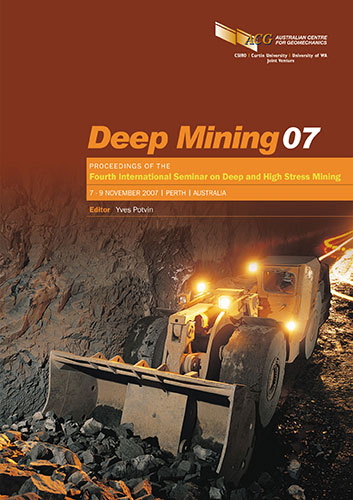Elastic Versus Inelastic Numerical Modelling of Deep and Highly Stressed Mining Fronts

|
Authors: Andrieux, PP; Brummer, RK; Li, H; O'Connor, CP |
DOI https://doi.org/10.36487/ACG_repo/711_4
Cite As:
Andrieux, PP, Brummer, RK, Li, H & O'Connor, CP 2007, 'Elastic Versus Inelastic Numerical Modelling of Deep and Highly Stressed Mining Fronts', in Y Potvin (ed.), Deep Mining 2007: Proceedings of the Fourth International Seminar on Deep and High Stress Mining, Australian Centre for Geomechanics, Perth, pp. 51-64, https://doi.org/10.36487/ACG_repo/711_4
Abstract:
With the current trend of exploiting mines at increasing depths comes the challenge of managing increasingly high stress conditions. One tool at the disposal of mine engineers and designers is the numerical simulation of the stresses and deformations likely to be encountered ahead of the mining fronts for various mining scenarios. Although the benefits of numerical modelling are by now well accepted throughout the industry, the applicability of the various types of numerical modelling approaches is not always well understood and still the subject of much debate. This paper endeavours to explain the basic differences between the elastic and inelastic approaches, as well as provide practical guidelines concerning which one to use for various sets of circumstances. Case studies of high stress situations are provided that show where the simpler elastic approach was adequate, and where implementing an inelastic approach was unavoidable. Some insight is also provided into the type of practical information that can be extracted from advanced failure analyses (the exclusive domain of inelastic techniques), such as determining the degree of failure of a rock mass by examining the stress state of its failed zones, which indicates their position along the strain-softening post-peak response typical of hard rock masses.
References:
Andrieux, P., Hudyma, M., O’Connor, C., Li, H., Cotesta, L. and Brummer, R. (2008) (in preparation) Calibration of
Large-Scale Three-Dimensional Non-Linear Numerical Models of Underground Mines Using Microseismicity
Data. Proceedings 1st International FLAC/DEM Symposium, Minneapolis, MN, USA, August 2008.
Andrieux, P., Zhu, H., Labrie, D., Doucet, C., Lampron, S. and Fleury, D. (2004) Determination and Validation of the
Rock Mass Post-Peak Mechanical Properties for a 3DEC Strain-Softening Model of the 680 Sill Pillar at
Louvicourt Mine. In Numerical Modelling of Discrete Materials in Geotechnical Engineering, Civil Engineering
and Earth Science, H. Konietzky (editor), pp. 121-127. Proceedings 1st International UDEC/3DEC Symposium,
Bochum, Germany, September 2004. Lisse: Balkema, 2004.
Assonvi, C. and Richter, R. (1979) The Continuum Theory of Rock Mechanics. Series on Rock and Soil Mechanics,
published by Trans Tech Publications, Inc., Zurich, Switzerland, 332 p.
Bieniawski, Z. (1989) Engineering Rock Mass Classifications: A Complete Manual for Engineers and Geologists in
Mining, Civil, and Petroleum Engineering. John Wiley & Sons publishers, New York, NY, USA, 272 p.
Hoek, E., Kaiser, P. and Bawden, W. (1995) Support of Underground Excavations in Hard Rock, Published by A.A.
Balkema, Rotterdam, Netherlands, 215 p.
Hoek, E. and Brown, E.T. (1980) Underground Excavations in Rock. Published by the Institution of Mining and
Metallurgy, 527 p, London, U.K.
Itasca (2003) 3DEC Theory and Background. Published by the Itasca Consulting Group, Minneapolis, MN, USA,
218 pp.
Elastic Versus Inelastic Numerical Modelling of Deep and Highly Stressed Mining Fronts P.P. Andrieux, et al.
64 Deep Mining 07, Perth, Australia
© Copyright 2025, Australian Centre for Geomechanics (ACG), The University of Western Australia. All rights reserved.
View copyright/legal information
Please direct any queries or error reports to repository-acg@uwa.edu.au
View copyright/legal information
Please direct any queries or error reports to repository-acg@uwa.edu.au